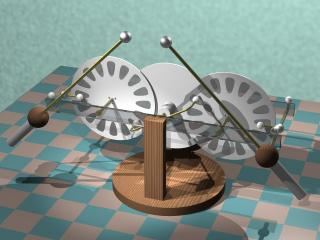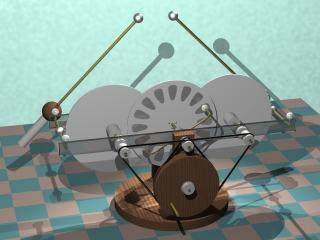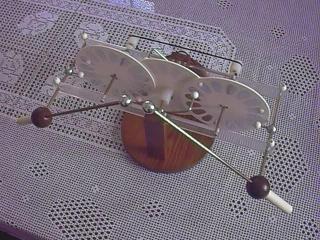

Another variation of the Wimshurst machine
The "unfolded Wimshurst machine":
Soon after completing the "half Wimshurst" machine, I made another, this time with three disks. I was hoping that the symmetrical operation of the central disk could eliminate the systematic periodical reversals of the machine. This machine should operate much as a regular Wimshurst machine (schematic), but with one of the disks split in two along the horizontal diameter, and "unfolded", becoming two disks, one above and other below the unmodified disk. In my implementation, the three resulting disks are mounted side-by-side. The three disks turn in the same direction, and with neutralizers mounted as in the Wimshurst machine (but reversed in my implementarion) there are two charge generation areas, at both sides of the central disk, corresponding to the two charge-generation areas at the upper and lower quadrants of the regular machine, where the disks, turning in opposite directions, touch the neutralizers. The machine is also equivalent to the "half" machine with an extra disk added at one side, and with a different assembly of the neutralizers.
Construction:
 I used essentially the same structural ideas of
the "half Wimshurst"
machine, but used even smaller disks, with only 14.5 cm of
diameter. The disks are turned by two cords, one turning the
central disk and the other turning the lateral disks, both
powered from a single driving pulley with two grooves. This time
I made the bearings of the three axles in brass, making
3/16" holes in short 1/4" brass bars that were inserted
in the acrylic supports. I added screws to fix the lateral
conductors to both insulating acrylic bars, for more solid
construction. I sectored the disks with quite small distances
between the sectors, hoping to compensate the small diameter of
the disks with more area for charge transport. The neutralizers
were mounted on brass rings that are supported by the tubes that
serve as bearings for the central disk, and can be rotated to any
angle. The terminals were made with solid aluminum balls with 1.5
cm of diameter. The charge collectors were mounted at the sides
of the lateral disks. Front view. Back view.
I used essentially the same structural ideas of
the "half Wimshurst"
machine, but used even smaller disks, with only 14.5 cm of
diameter. The disks are turned by two cords, one turning the
central disk and the other turning the lateral disks, both
powered from a single driving pulley with two grooves. This time
I made the bearings of the three axles in brass, making
3/16" holes in short 1/4" brass bars that were inserted
in the acrylic supports. I added screws to fix the lateral
conductors to both insulating acrylic bars, for more solid
construction. I sectored the disks with quite small distances
between the sectors, hoping to compensate the small diameter of
the disks with more area for charge transport. The neutralizers
were mounted on brass rings that are supported by the tubes that
serve as bearings for the central disk, and can be rotated to any
angle. The terminals were made with solid aluminum balls with 1.5
cm of diameter. The charge collectors were mounted at the sides
of the lateral disks. Front view. Back view.
Performance:
The first thing that I noticed is that it reverts almost as the "half" machine. If the air humidity is high, or the disks are dirty, it can retain the same polarity for long time, but with reduced output. The small disks with small distances between sectors caused small output sparks, reaching at most 2 cm. The output current is as expected: 5 uA with 4 turn/second at the crank. The same current that would be expected from a regular machine with these disks. I tried to remove half of the sectors of the disks to see if the output voltage could be increased. This resulted in some improvement, but when I removed half of the sectors of the central disk the machine ceased to start without external excitation. I then put back all the sectors, but with greater separation between them (spacing identical to average width), resulting is a small gain in spark length. I was hoping also that the machine could work also when turned backwards, as a regular machine does, but it doesn't work in this way.
Created: 2/5/2001
Last update: 17/7/2001
Developed and maintained by Antonio Carlos
M. de Queiroz
Return to Electrostatic Machines